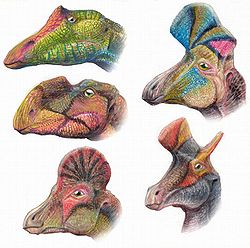- Iguanodont
-
Iguanodont
Temporal range: Late Jurassic–Late Cretaceous, 156–65.5 Ma
Heads of different iguanodonts Scientific classification 
Kingdom: Animalia Phylum: Chordata Class: Reptilia Superorder: Dinosauria Order: †Ornithischia Node: †Cerapoda Suborder: †Ornithopoda Branch: †Iguanodontia
Dollo, 1888Subgroups - Dryomorpha
- Rhabdodontidae
- Tenontosaurus
And see text.
Iguanodonts (members of the group Iguanodontia) were herbivorous dinosaurs that lived from the mid-Jurassic to Late Cretaceous. Some members include Camptosaurus, Callovosaurus, Iguanodon, Ouranosaurus, and the hadrosaurids or "duck-billed dinosaurs". Iguanodonts were one of the first groups of dinosaurs to be found. They are among the best known of the dinosaurs, and were among the most diverse and widespread herbivorous dinosaur groups of the Cretaceous period.[1] Iguanodontians were generally large animals, and some (such as Shantungosaurus, which measured up to 50 ft (15 m) in length and weighed up to 8 tons) equaled the largest carnivorous dinosaurs in size.
Classification
Iguanodontia is often listed as an infraorder within a suborder Ornithopoda, though Benton (2004) lists Ornithopoda as an infraorder and does not rank Iguanodontia. Traditionally, iguanodonts were grouped into the superfamily Iguanodontoidea and family Iguanodontidae. However, phylogenetic studies show that the traditional "iguanodontids" are a paraphyletic grade leading up to the hadrosaurs (duck-billed dinosaurs). Groups like Iguanodontoidea are sometimes still used as unranked clades in the scientific literature, though many traditional "iguanodontids" are now included in the more inclusive group Hadrosauroidea.
Iguanodontia is usually defined as the most inclusive group containing Parasaurolophus walkeri but not Hypsilophodon foxii or Thescelosaurus neglectus, or other combinations of species that would ultimately result in the same group in most modern analyses. The group was first defined as a clade in 2008 by Paul Sereno.[2]
Many iguanodonts have not yet been included in a large phylogenetic analyses, or are too fragmentary to place confidently. These include Barilium, Bolong, Bihariosaurus, Delapparentia, Dollodon, Draconyx, Kukufeldia,[3] Hypselospinus, Macrogryphosaurus, Owenodon, Proplanicoxa,[4] Sellacoxa[4] and Xuwulong. The simplified cladogram below follows an analysis by Andrew McDonald and colleagues, published in November 2010 with information from McDonald, 2011.[1][5]
Iguanodontia Dryomorpha Ankylopollexia Styracosterna Uteodon
Hippodraco
Iguanacolossus
Hadrosauriformes Cladogram after Butler et al, 2011.[6]
Iguanodontia Tenontosaurus Ankylopollexia
References
- ^ a b McDonald, A.T., Kirkland, J.I., DeBlieux, D.D., Madsen, S.K., Cavin, J., Milner, A.R.C. and Panzarin, L. (2010). "New Basal Iguanodonts from the Cedar Mountain Formation of Utah and the Evolution of Thumb-Spiked Dinosaurs." PLoS ONE 5, 11: e14075. doi:10.1371/journal.pone.0014075
- ^ Sereno, P.C. (2005). "Stem Archosauria Version 1.0." TaxonSearch. Available: http://www.taxonsearch.org/Archive/stem-archosauria-1.0.php via the Internet. Accessed 24 November 2010.
- ^ McDonald, A.T., Barrett, P.M. and Chapman, S.D. (2010). "A new basal iguanodont (Dinosauria: Ornithischia) from the Wealden (Lower Cretaceous) of England." Zootaxa, 2569: 1–43.
- ^ a b Carpenter, K. and Ishida, Y. (2010). "Early and "Middle" Cretaceous Iguanodonts in Time and Space". Journal of Iberian Geology 36 (2): 145–164. doi:10.5209/rev_JIGE.2010.v36.n2.3. http://www.ucm.es/info/estratig/JIG/vol_content/vol_36_2/36_2_145_164_Carpenter.pdf.
- ^ Andrew T. McDonald (2011). "The taxonomy of species assigned to Camptosaurus (Dinosauria: Ornithopoda)". Zootaxa 2783: 52–68. http://www.mapress.com/zootaxa/2011/f/z02783p068f.pdf.
- ^ Richard J. Butler, Jin Liyong, Chen Jun, Pascal Godefroit (2011). "The postcranial osteology and phylogenetic position of the small ornithischian dinosaur Changchunsaurus parvus from the Quantou Formation (Cretaceous: Aptian–Cenomanian) of Jilin Province, north-eastern China". Palaeontology 54 (3): 667–683. doi:10.1111/j.1475-4983.2011.01046.x.
Categories:- Iguanodonts
Wikimedia Foundation. 2010.
